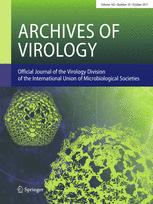Ver ítem
- xmlui.general.dspace_homeCentros e Institutos de InvestigaciónCICVyA. Centro de Investigación en Ciencias Veterinarias y AgronómicasInstituto de GenéticaArtículos científicosxmlui.ArtifactBrowser.ItemViewer.trail
- Inicio
- Centros e Institutos de Investigación
- CICVyA. Centro de Investigación en Ciencias Veterinarias y Agronómicas
- Instituto de Genética
- Artículos científicos
- Ver ítem
Association of TNF-α gene promoter region polymorphisms in bovine leukemia virus (BLV)-infected cattle with different proviral loads
Resumen
Tumor necrosis factor alpha (TNF-α) is a pleiotropic cytokine involved in the immune response against viral and other infections. Its expression levels are affected by a polymorphism in the promoter region of the gene. Bovine leukemia virus is a retrovirus that infects cattle and develops two different infection profiles in the host. One profile is characterized by a high number of proviral copies integrated into the host genome and a strong immune
[ver mas...]
Tumor necrosis factor alpha (TNF-α) is a pleiotropic cytokine involved in the immune response against viral and other infections. Its expression levels are affected by a polymorphism in the promoter region of the gene. Bovine leukemia virus is a retrovirus that infects cattle and develops two different infection profiles in the host. One profile is characterized by a high number of proviral copies integrated into the host genome and a strong immune response against the virus, while the most relevant property of the other profile is that the number of copies integrated into the host genome is almost undetectable and the immune response is very weak. We selected a population of cattle sufficiently large for statistical analysis and classified them according to whether they had a high or low proviral load (HPL or LPL). Polymorphisms in the promoter region were identified by PCR-RFLP. The results indicated that, in the HPL group, the three possible genotypes were normally distributed and that, in the LPL group, there was a significant association between the proviral load and a low frequency of the G/G genotype at position -824.
[Cerrar]

Autor
Lendez, Pamela Anahi;
Passucci, Juan Antonio;
Poli, Mario Andres;
Gutierrez, Silvina Elena;
Dolcini, Guillermina Laura;
Ceriani, Maria Carolina;
Fuente
Archives of virology 160 (8) : 2001–2007. (August 2015)
Fecha
2015-08
ISSN
0304-8608 (Print)
1432-8798 (Online)
1432-8798 (Online)
Formato
pdf
Tipo de documento
artículo
Palabras Claves
Derechos de acceso
Restringido
 Excepto donde se diga explicitamente, este item se publica bajo la siguiente descripción: Creative Commons Attribution-NonCommercial-ShareAlike 2.5 Unported (CC BY-NC-SA 2.5)
Excepto donde se diga explicitamente, este item se publica bajo la siguiente descripción: Creative Commons Attribution-NonCommercial-ShareAlike 2.5 Unported (CC BY-NC-SA 2.5)

